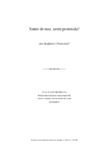Mostrar o rexistro simple do ítem
Xente de mar, xente protexida?
| dc.contributor.author | Louro Rodríguez, Julio | es_ES |
| dc.date.accessioned | 2015-11-09T09:12:00Z | |
| dc.date.available | 2015-11-09T09:12:00Z | |
| dc.date.issued | 2013 | es_ES |
| dc.identifier.citation | Anuario da Facultade de Ciencias do Traballo da Universidade da Coruña, 2013,4:275-305.ISSN: 2173-9811 | es_ES |
| dc.identifier.issn | 2173-9811 | es_ES |
| dc.identifier.uri | http://hdl.handle.net/2183/15487 | |
| dc.description.abstract | [Resumo] Que o mar é un xerador de riqueza é algo que ninguén dúbida: foino no pasado, éo no presente e serao, probablemente aínda máis, no futuro. E para afirmar que Europa é un continente marítimo, abonda o seguinte dato: «o 90% do comercio exterior da Unión Europea e máis do 40% do seu comercio interior efectúase por mar» (Comisión Europea, 2006). Neste contexto Galicia é líder en xente de mar: pesca e transporte marítimo. Conta cunha das sete escolas técnicas superiores de Náutica e Máquinas que existen en España. O 23 de outubro de 1549 o Concello da Coruña, por orde do rei Filipe II, acordou crear unha Cátedra de Gramática e Estudos do Mar. Desde entón, esta cidade formou oficiais da mariña mercante de recoñecido prestixio no mundo marítimo. Por outra banda, Galicia achega máis da metade do emprego pesqueiro de España e un 10% do conxunto da Unión Europea (UE). Con case 6000 embarcacións –pesca máis acuicultura–, a frota pesqueira galega supón o 48% do total nacional en 2013. Canto á súa dependencia social, poden resaltarse vilas como Bueu ou Ribeira, onde o emprego pesqueiro representa o 30% da poboación ocupada, que chega a valores do 60% na Illa de Arousa. Ora ben, os traballadores do mar non gozan dos mesmos niveis de protección que os do resto de actividades no tocante ás relacións laborais. O efecto máis inmediato disto é a falta de man de obra cualificada; e o seu efecto máis pernicioso, a perda de saúde dos traballadores. Como veremos ao longo deste traballo, a xente de mar desenvolve a súa xornada nunhas condicións realmente moi difíciles, nun medio inhóspito, agresivo ás veces. Unha mellora nas condicións laborais faría, sen dúbida, máis seguro e máis atractivo o traballo no mar, preocupacións ambas tanto das Nacións Unidas como da UE. Co obxectivo de abrir unha xanela, actualizada con data de 2013, a estas peculiares condicións de traballo que pola súa vez son condicións de vida, e facendo énfase no máis mellorable –lugares de traballo, ruído, enfermidades profesionais, vibracións, estatísticas, sinistralidade–, pomos ao día as distintas publicacións sobre o tema, case sempre acompañados por excelentes colegas investigadores. Todas elas tratan sobre a seguridade e a saúde laboral da xente de mar desde distintas perspectivas: profesional, xurídica, preventiva, científica... | es_ES |
| dc.description.abstract | [Abstract] Nobody doubts that the sea is a source of wealth: it has been in the past, it is in the present and it will be, probably even more, in the future. Europe is a maritime continent: 90 % of European Union foreign trade and more than 40 % of its domestic trade is carried out by sea (European Commission, 2006). In this context Galicia is a leading region in sea workforce both in fishing and maritime transport sectors. One of the seven Spanish High Technical Colleges of Nautical Sciences and Marine Engineering is settled in Galicia. On October 23, 1549 La Corunna city council, by order of King Philip II, agreed to create a Chair of “Grammar and Sea Studies”. Since then, this city has educated and trained Merchant Marine Officers that are highly recognized in the maritime world. Also, Galicia provides more than a half of the Spanish fishing employment and 10 % of the European Union one. With almost 6,000 ships (devoted to fishing and aquiculture), the Galician fishing fleet is 48 % of the national fishing fleet (2013). With regard to its social value, Bueu and Ribeira are two examples of towns where fishing employment represents 30 % of the working population, coming to values of 60 % in Illa de Arousa town. But sea workers have not the same levels of occupational protection than the rest of working activities. The most immediate effect is the lack of skilled workforce; the most harmful one is the loss of workers’ health. We will see in this work that sea workers develop their working activities in very hard working conditions, in an inhospitable and sometimes aggressive environment. Improvements in these working conditions would undoubtedly make the work at sea safer and more attractive. These are both concerns of United Nations and European Union. With the purpose of reviewing the state of the art, this author shows the characteristic working and living conditions, emphasizing those improvable aspects (workplaces, noise, occupational diseases, vibrations, statistics and accident rates). In addition, several publications carried out on this topic are updated. All these publications are related to Occupational Safety and Health of sea workers from several perspectives such as the professional, juridical, preventionist and scientific ones. | es_ES |
| dc.language.iso | glg | es_ES |
| dc.publisher | Universidade da Coruña | es_ES |
| dc.subject | Sector marítimo | es_ES |
| dc.subject | Xente de mar | es_ES |
| dc.subject | Condicións de traballo | es_ES |
| dc.subject | Maritime sector | es_ES |
| dc.subject | Sea workers | es_ES |
| dc.subject | Working conditions | es_ES |
| dc.title | Xente de mar, xente protexida? | es_ES |
| dc.title.alternative | Are Seafarers Protected? | es_ES |
| dc.type | info:eu-repo/semantics/article | es_ES |
| dc.rights.access | info:eu-repo/semantics/openAccess | es_ES |






